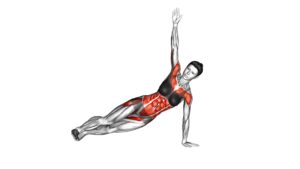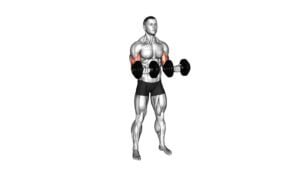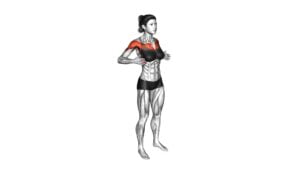Rotate and Leg Lift Crunch (male) – Video Exercise Guide & Tips

Are you looking to strengthen your core and tone your abs? You've come to the right place!
Watch This Exercise Video
In this video exercise guide, we'll show you how to perform the Rotate and Leg Lift Crunch. This exercise targets your obliques and lower abs, helping you achieve a stronger and more defined midsection.
With proper form and technique, you'll be on your way to a fitter, healthier you. So grab a mat and get ready to feel the burn!
Key Takeaways
- The Rotate and Leg Lift Crunch targets abdominal muscles and engages hip flexors for improved athletic performance.
- Proper form and technique, such as maintaining a straight spine and relaxed neck, are important to prevent injuries.
- Engaging core muscles throughout the exercise and focusing on correct body alignment helps to strengthen the midsection and improve stability.
- Proper breathing technique, including exhaling during rotation and leg lift, enhances performance and muscle oxygenation.
Benefits of the Rotate and Leg Lift Crunch
To experience the full benefits of the Rotate and Leg Lift Crunch, focus on engaging your core muscles and maintaining proper form throughout the exercise. This dynamic move offers several advantages for your fitness routine.
Firstly, it effectively targets your abdominal muscles, including the rectus abdominis and obliques, helping you to develop a stronger and more defined midsection. By incorporating rotation and leg lifts into the crunch, you engage these muscles in a more comprehensive way, leading to increased strength and stability.
Secondly, this exercise also activates the hip flexors, which are crucial for activities such as running, jumping, and even walking. By strengthening these muscles, you improve your overall athletic performance and reduce the risk of injury.
Finally, the Rotate and Leg Lift Crunch is an efficient and time-saving exercise, as it targets multiple muscle groups simultaneously. This makes it a great addition to any workout routine, allowing you to maximize your time at the gym.
Now that you understand the advantages and effectiveness of this exercise, let's move on to discussing the proper form and technique for performing it.
Proper Form and Technique for the Exercise
To perform the Rotate and Leg Lift Crunch with proper form and technique, it's important to focus on correct body alignment, engage your core muscles, and utilize the right breathing technique.
Maintain a straight spine throughout the exercise, keeping your neck relaxed and your shoulders away from your ears.
Contract your abdominal muscles as you rotate and lift your legs, exhaling as you crunch and inhaling as you lower down.
Correct Body Alignment
Ensure proper body alignment during the Rotate and Leg Lift Crunch exercise by keeping your back straight and engaging your core muscles. Body alignment is of utmost importance in any exercise as it helps prevent injuries and maximizes the effectiveness of the movement.
Common body alignment mistakes to avoid during this exercise include rounding your back, hunching your shoulders, and lifting your legs too high. To maintain correct alignment, imagine a straight line running from your head to your tailbone, and keep your shoulders relaxed and down.
As you transition into the next section about engaging core muscles, remember that a strong core is essential for stability and proper body alignment throughout the exercise.
Engaging Core Muscles
Maintain proper body alignment and engage your core muscles to perform the Rotate and Leg Lift Crunch exercise effectively. To ensure you're engaging your core muscles properly, keep the following tips in mind:
- Focus on contracting your abdominal muscles throughout the entire exercise.
- Keep your lower back pressed firmly against the floor to avoid straining your back.
- Modify the exercise by bending your knees if you have difficulty keeping your legs straight.
By engaging your core muscles, you won't only strengthen your abs but also improve your overall stability and posture.
Don't forget to listen to your body and make any necessary modifications to suit your individual needs and fitness level.
Now, let's move on to the next section where we'll discuss the importance of proper breathing technique during this exercise.
Breathing Technique
Now, let's focus on how you can properly breathe during the Rotate and Leg Lift Crunch exercise to maximize its effectiveness.
Proper breathing technique is essential for any exercise, including this one. When performing the Rotate and Leg Lift Crunch, it's important to exhale as you rotate your torso and lift your legs off the ground. This exhalation helps engage your core muscles and provides stability during the movement.
As you lower your legs and return to the starting position, inhale deeply to replenish oxygen to your muscles. By coordinating your breathing with the exercise, you can enhance your performance and ensure that your muscles receive the oxygen they need.
Common Mistakes to Avoid
To ensure you get the most out of the Rotate and Leg Lift Crunch exercise and minimize the risk of injury, it's important to avoid common mistakes.
One common mistake is using improper form, which can put strain on your back and neck.
Additionally, not engaging your core muscles properly can limit the effectiveness of the exercise.
Improper Form Risks Injury
Avoiding proper form during the Rotate and Leg Lift Crunch exercise increases the risk of injury. It's crucial to maintain the correct form to reap the benefits of this exercise and avoid potential harm. Here are three common mistakes to avoid:
- Poor posture: Maintaining proper alignment is essential to prevent strain on your back and neck. Keep your spine neutral and engage your core throughout the movement.
- Lack of warm-up: Skipping a warm-up session can lead to muscle tightness and increase the risk of injury. Warm-up exercises prepare your muscles for the workout and improve flexibility.
- Neglecting cooldown: Cooling down after the exercise allows your heart rate to gradually return to normal and aids in reducing muscle soreness. It promotes proper recovery and prevents post-workout stiffness.
Not Engaging Core Muscles
To avoid the common mistake of not engaging your core muscles during the Rotate and Leg Lift Crunch exercise, focus on maintaining proper form and activating your abdominal muscles throughout the movement. Improper technique and lack of focus can prevent the activation of your core muscles, leading to less effective results and potentially increasing the risk of injury.
When performing the Rotate and Leg Lift Crunch, make sure to keep your core tight and contracted throughout the entire exercise. This means pulling your belly button in towards your spine and maintaining that engagement as you rotate and lift your legs.
Modifications and Progressions for All Fitness Levels
Start with a simple modification by adding a number of repetitions to challenge yourself at any fitness level. Here are some exercise modifications and progressions for different fitness levels:
- Increase the number of repetitions: Start by performing the rotate and leg lift crunch with a lower number of repetitions, such as 5-10, and gradually increase it as you get stronger and more comfortable with the exercise.
- Add weights: Once you have mastered the basic form of the exercise, you can add weights to increase the intensity. Hold a dumbbell or a weighted plate against your chest while performing the crunch to engage your core muscles even more.
- Incorporate variations: To further challenge yourself, you can try different variations of the rotate and leg lift crunch. For example, you can perform the exercise on an unstable surface like a stability ball or a Bosu ball, which will require more core stability and balance.
By incorporating these modifications and progressions into your workout routine, you can continuously challenge your body and prevent plateaus.
Now, let's move on to the next section for tips on how to get the most out of your workout.
Tips for Getting the Most Out of Your Workout
To maximize your workout results, focus on proper form and technique throughout your exercises. This is crucial for maximizing results and preventing injuries. When performing each exercise, pay attention to your body alignment, engage your core, and use the correct muscles. This will ensure that you're targeting the intended muscle groups and getting the most out of each movement.
In addition to proper form, pre-workout nutrition plays a vital role in optimizing your workout. Fueling your body with the right nutrients and energy can enhance your performance and help you push through intense workouts. Prior to your workout, consume a balanced meal or snack that includes carbohydrates for energy, protein for muscle repair and recovery, and healthy fats for sustained energy.
Remember to stay hydrated throughout your workout as well. Dehydration can negatively impact your performance and hinder your progress. Drink water before, during, and after your workout to maintain proper hydration levels.
By focusing on proper form and technique, as well as fueling your body with the right nutrients, you can maximize your workout results and achieve your fitness goals more effectively.
Now, let's move on to the next section about safety precautions and considerations, which are equally important for a successful workout.
Safety Precautions and Considerations
Ensure your safety and prevent injuries during your workout by following these essential safety precautions and considerations.
- Warm up exercises: Before starting any intense workout, it's crucial to warm up your muscles and increase your heart rate gradually. Engaging in light cardio exercises such as jogging or jumping jacks for 5-10 minutes can help prepare your body for the upcoming workout and reduce the risk of injury.
- Use proper form and technique: When performing the rotate and leg lift crunch, it's important to maintain proper form and technique to avoid strain or injury. Keep your core engaged, your back straight, and perform the movement with control and precision. Avoid using momentum or jerking motions that can put unnecessary stress on your muscles and joints.
- Listen to your body: Pay attention to any discomfort or pain during the exercise. If you experience sharp or intense pain, stop immediately and consult a healthcare professional. Pushing through pain can lead to further injury and setbacks in your fitness journey.
By incorporating these injury prevention strategies and taking the necessary precautions, you can maximize the effectiveness of your workout while minimizing the risk of injuries.
Remember to always prioritize safety and consult with a fitness professional if you have any concerns or questions.
Frequently Asked Questions
How Many Sets and Reps Should I Do for the Rotate and Leg Lift Crunch Exercise?
To determine the number of sets and reps for the rotate and leg lift crunch exercise, you can consider factors like your fitness level and goals.
It's a core exercise that targets your abs and obliques. The rotation adds an extra challenge to engage more muscles.
Start with 2-3 sets of 10-12 reps, and gradually increase as you get stronger.
Remember to listen to your body and make modifications if needed, such as bending your knees or using a stability ball for support.
Can I Perform the Rotate and Leg Lift Crunch Exercise on a Stability Ball Instead of the Floor?
Yes, you can perform the rotate and leg lift crunch exercise on a stability ball instead of the floor. Doing this exercise on a stability ball adds an extra challenge to your core muscles as you work to maintain balance.
It also engages your stabilizer muscles, improves posture, and increases overall core strength.
Incorporating stability ball variations into your workout routine can help diversify your exercises and target different muscle groups.
Is It Normal to Feel a Burning Sensation in My Abs During the Rotate and Leg Lift Crunch Exercise?
Feeling a burning sensation in your abs during the rotate and leg lift crunch exercise is normal. This exercise targets your abdominal muscles, engaging them in a challenging way. The burning sensation indicates that your muscles are working hard and being activated. It's a sign that you're pushing yourself and making progress.
However, if the burning becomes too intense or is accompanied by pain, it's important to listen to your body and modify the exercise or consult a professional.
Can I Incorporate Weights or Resistance Bands Into the Rotate and Leg Lift Crunch Exercise for Added Difficulty?
Yes, you can definitely incorporate weights or resistance bands into the rotate and leg lift crunch exercise for added difficulty. Adding weights or resistance bands will increase the resistance and challenge your muscles even more.
You can also try using a stability ball for added difficulty, as it will require more core stability. However, it's important to start with lighter weights and gradually increase the intensity to avoid injury.
As for the optimal frequency, it's recommended to perform this exercise 2-3 times a week.
How Often Should I Include the Rotate and Leg Lift Crunch Exercise in My Workout Routine for Optimal Results?
To achieve optimal results, include the rotate and leg lift crunch exercise in your workout routine regularly.
The frequency of this exercise depends on your fitness goals and overall workout plan. Including it 2-3 times a week can help strengthen your core, improve stability, and enhance overall body control.
The rotate and leg lift crunch is an effective exercise that targets multiple muscle groups, making it a valuable addition to your fitness routine.
Conclusion
Incorporating the rotate and leg lift crunch into your workout routine can offer numerous benefits, including strengthening your core muscles and improving stability.
By maintaining proper form and technique, you can maximize the effectiveness of this exercise and avoid common mistakes.
Modifications and progressions are available for individuals of all fitness levels, allowing for a customized workout experience.
Remember to follow safety precautions and consider your own limitations while performing this exercise.
With these tips in mind, you can make the most out of your workout and achieve your fitness goals.

Author
Years ago, the spark of my life’s passion ignited in my mind the moment I stepped into the local gym for the first time. The inaugural bead of perspiration, the initial endeavor, the very first surge of endorphins, and a sense of pride that washed over me post-workout marked the beginning of my deep-seated interest in strength sports, fitness, and sports nutrition. This very curiosity blossomed rapidly into a profound fascination, propelling me to earn a Master’s degree in Physical Education from the Academy of Physical Education in Krakow, followed by a Sports Manager diploma from the Jagiellonian University. My journey of growth led me to gain more specialized qualifications, such as being a certified personal trainer with a focus on sports dietetics, a lifeguard, and an instructor for wellness and corrective gymnastics. Theoretical knowledge paired seamlessly with practical experience, reinforcing my belief that the transformation of individuals under my guidance was also a reflection of my personal growth. This belief holds true even today. Each day, I strive to push the boundaries and explore new realms. These realms gently elevate me to greater heights. The unique combination of passion for my field and the continuous quest for growth fuels my drive to break new ground.







